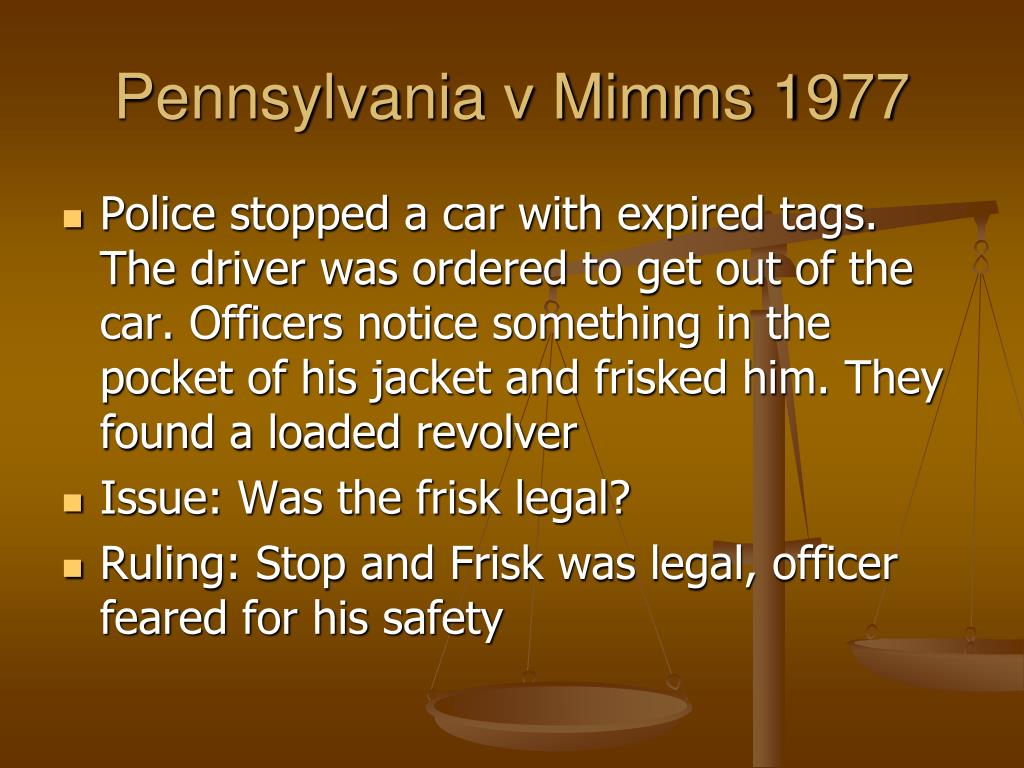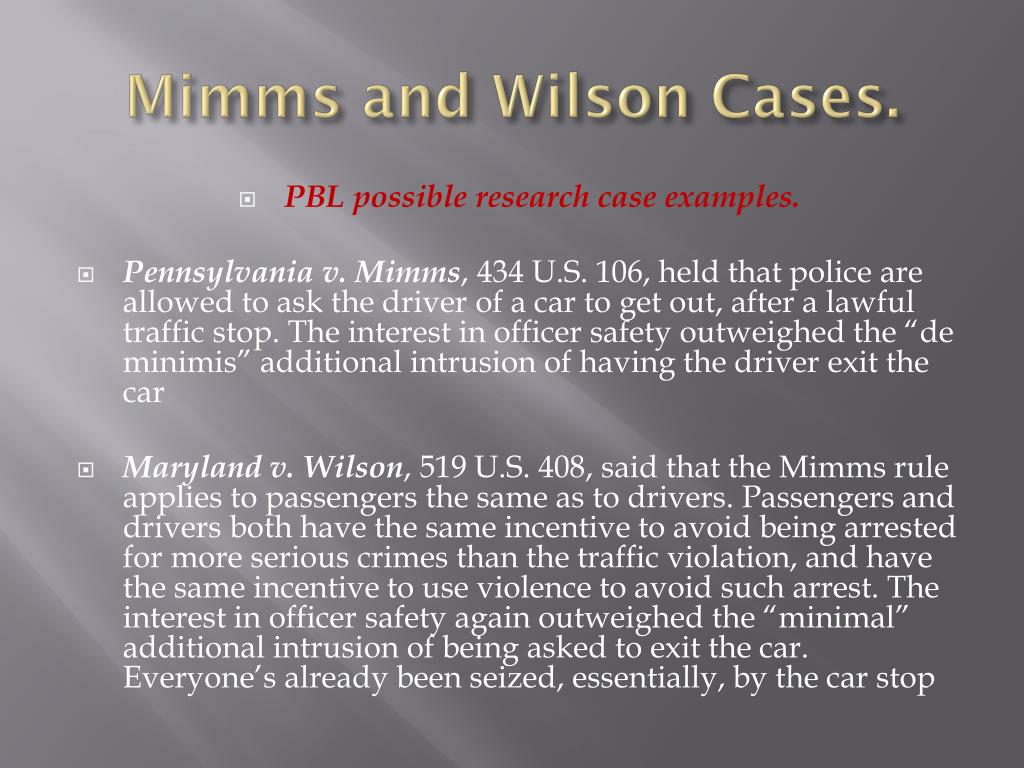Has the Fourth Amendment been stretched too thin in the name of officer safety? The landmark case of Pennsylvania v. Mimms, decided by the United States Supreme Court in 1977, continues to spark debate about the balance between law enforcement's need for safety and an individual's right to be free from unreasonable searches and seizures.
The core of the controversy revolves around the simple act of a police officer ordering a driver out of their vehicle during a traffic stop. The Supreme Court, in Mimms, determined that this action does not violate the Fourth Amendment, ruling that it is a "mere inconvenience" justified by the legitimate interest in officer safety. This seemingly minor detail has, however, become a significant point of contention, as it sets a precedent for how much control officers can exert during such encounters.
The case originated in Philadelphia. In 1974, two Philadelphia police officers pulled over Harry Mimms for driving with an expired license plate. After requesting that Mimms exit the vehicle, the officers noticed a suspicious bulge under his jacket. Their subsequent search revealed a concealed .38-caliber revolver, leading to Mimms's conviction on weapons charges. The Pennsylvania Supreme Court ultimately overturned the conviction, holding the search unconstitutional, which then led the case to the United States Supreme Court.
- Ethan Hila Klein Rumors Baby 3 More
- Jocelyn Wildenstein Before After Catwoman Transformation Uncovered
The Supreme Court's rationale was built upon several key considerations. First, the Court acknowledged the inherent danger faced by police officers during traffic stops, which, though often routine, can quickly escalate. Second, it found the intrusion on Mimms's personal liberty the request to exit the vehicle to be minimal. The Court, in its decision, cited that this diminished the possibility that the driver could make unobserved movements preparatory to assaulting the officer. The Court believed this minimal intrusion was outweighed by the interest in officer safety.
The ruling in Mimms, while seemingly straightforward, has had far-reaching implications. It has been cited in numerous subsequent cases, shaping law enforcement practices nationwide. The decision provided officers with a degree of discretion to maintain control over the situation, prioritizing their safety.
The ruling also established a precedent for the balance of officer safety and individual rights. The Court made it clear that even a brief intrusion on personal liberty is permissible if justified by a compelling state interest, such as officer safety. This principle has since been applied in other areas of law enforcement, further shaping the landscape of interactions between citizens and the police.
- Shadowhunters Cast Story Where To Watch Your Ultimate Guide
- Emiru Nudes Leaked See The Viral Pics Videos Now
The implications of this case were so significant, that professional law enforcement groups submitted briefs. In one instance, the AAELE (American Association of Equipment Leasing), speaking for several professional law enforcement groups, argued in favor of officers being permitted to control vehicle passengers.
The case of Maryland v. - is related to the issue of law enforcement procedures during traffic stops, like Mimms.
The court found that the "bulge in the defendant's jacket permitted the officer to conclude that the defendant was armed and thus posed a serious and present danger to the safety of the officers." However, the legal concept of a search and seizure must be considered.
The Fourth Amendment, of the United States Constitution, protects against unreasonable searches and seizures. The standard of reasonableness is at the heart of Fourth Amendment jurisprudence.
| Information Category | Details |
|---|---|
| Case Name | Pennsylvania v. Mimms |
| Year Decided | 1977 |
| Court | United States Supreme Court |
| Key Issue | Whether an officer ordering a driver out of a vehicle during a traffic stop violates the Fourth Amendment's protection against unreasonable search and seizure. |
| Ruling | The Court ruled that it is permissible for an officer to order a driver out of a vehicle during a traffic stop, as a matter of officer safety, without violating the Fourth Amendment. This is considered a reasonable intrusion. |
| Legal Doctrine/Precedent Established | The Court established a precedent regarding the permissible scope of officer actions during traffic stops, and it established a standard for balancing Fourth Amendment protections with officer safety concerns. |
| Related Cases Mentioned | Terry v. Ohio, Sibron v. New York, New York v. Belton |
| Location | Philadelphia, Pennsylvania (initial stop); Washington, D.C. (Supreme Court) |
| Citation | 434 U.S. 106 (1977) |
| Reference Website | Justia - Pennsylvania v. Mimms |
The court's decision in Mimms was not without its critics. Some legal scholars and civil liberties advocates argue that the ruling gives police officers too much power, potentially leading to unnecessary intrusions on individual rights. The dissenting justices in the case raised concerns about the precedent set by the majority's decision, fearing its potential for abuse. However, the majority opinion, written by Chief Justice Warren E. Burger, prevailed, establishing the legal standard that continues to guide law enforcement practices today.
This case has had significant implications for law enforcement practices during traffic stops. The court's ruling created a legal baseline regarding the balance of Fourth Amendment rights with officer safety. This decision has been cited in subsequent cases, influencing the conduct of law enforcement officers across the nation.
The court's decision, furthermore, addressed the specific actions taken during the traffic stop. After asking Mimms to exit the car, the officers noticed an unusual bulge underneath his jacket. This observation, combined with their prior justification for the stop, led them to conduct a search that revealed a concealed weapon.
The case touched upon the issue of "stop and frisk" the practice of briefly detaining a person to search them for weapons. It is related to the court's decision in Terry v. Ohio. The court's decision in Terry allowed police officers to stop and frisk an individual if they had a reasonable suspicion that the person was involved in criminal activity. In Mimms, the court extended this principle by allowing officers to order a driver out of a vehicle during a traffic stop.
It's important to note that the context in which Mimms was decided is crucial. The late 1960s and early 1970s were marked by increased crime rates and a heightened awareness of the dangers faced by law enforcement officers. The Court, in its Mimms decision, explicitly acknowledged these concerns and sought to balance the need for officer safety with the protection of individual rights.
One of the arguments made by the defense was that the police officers' actions, ordering Mimms out of the car, constituted an unreasonable seizure. The court, however, disagreed, arguing that the order was justified by the need to ensure officer safety.
Another important point that emerged from this case and the legal arguments surrounding it is that the Fourth Amendment's protection against unreasonable searches and seizures is not absolute. There are exceptions to the rule, and officer safety is one of them.
The case also involved the question of whether the search of Mimms's person, after he exited the vehicle, was a valid search. The court's decision to allow the officers to order Mimms out of the car was the first step that led to the search. The court emphasized the importance of not second-guessing the split-second decisions of law enforcement officers.
The Supreme Court's decision in Mimms has been both praised and criticized. On one hand, it's seen as a way to protect officers in dangerous situations. On the other hand, it has been criticized for giving police officers too much leeway, potentially leading to the abuse of power. The decision has shaped the evolution of law enforcement practices.
The legal concept of 'reasonable suspicion' plays a crucial role in many of these cases. For example, Sibron v. New York, 392 U.S. 40 (1968), dealt with the same issue but found different grounds for the search.
The court's decision in Pennsylvania v. Mimms remains a focal point for those who study the nuances of law enforcement and the Constitution. The arguments presented by all sides in the case help to inform the ongoing debate over balancing officer safety with individual liberties.


